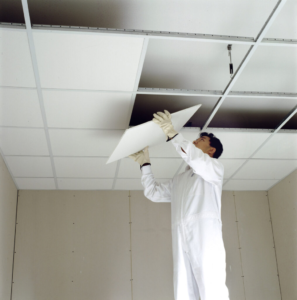A damaged roof can create an insidious and obtrusive problem for a home. Whether it’s leaky, sagging, or missing tiles, a thorough inspection is needed to determine the extent of the damage.

Repairing your roof requires a combination of tools and skill. The most important thing is to identify the damage and to fix it correctly. Contact Roof Repair Columbus GA for professional help.
Often overlooked until something goes wrong, the roof structure of a building is one of the most critical components. Not only does it protect from the elements but it also contributes to the overall structural integrity of the building. Neglecting to repair roof structure damage can result in significant problems, including water leaks and mold growth. Timely repairs are crucial for extending the life of your roof and protecting the health and safety of your family and home.
A roof is made of many different parts, and each part has its own specific function. Generally, the roof structure is designed to support the roof build-up and provide thermal and acoustic insulation. However, it can also be used for things such as dormers, skylights and chimneys. A roof should be inspected regularly to ensure that it is in good condition and that any necessary repairs are made.
Some of the most common roof issues are water leaks and sagging, which can lead to serious structural problems. Water leaks should be addressed as soon as they are detected, as even small leaks can cause severe and costly water damage if not dealt with promptly. Sagging, on the other hand, indicates that the roof is under too much weight and may need structural repairs.
In modern buildings, a roof is typically constructed from prefabricated trusses or joists and covered with plywood sheathing. These materials provide a sturdy base for the rest of the roof, and they also act as a barrier against moisture.
Other parts of the roof include a fascia and flashing, which are both important for providing protection from moisture. In addition, scuppers and downspouts are essential for draining water from the roof and preventing it from collecting near the foundation of the house.
Older houses sometimes have a more complex roof structure, with a series of rafters supporting a timber ceiling. These rafters are joined at the top of the ceiling at a point known as the roof ridge. The ridge is also often covered with ridge tiles, which help to keep rain and other debris out of the building. In some cases, a roof may need to be replaced entirely, especially if it has sustained major damage over time.
Shingles
A roof’s shingles are the most recognizable part of its structure and provide an important layer of protection to your home. The various shingle types—asphalt, wood, clay or slate—are designed to work together through their specific layering patterns to create a barrier that keeps rain and other weather elements from seeping into your home.
However, shingles do not last forever and will need to be replaced from time to time. When this happens, it is important to know the best methods for roof repair so you can address them quickly and ensure your home stays safe and protected.
Before you tackle any roofing repairs, you should ensure that you have all the necessary materials. You’ll need replacement shingles, a pry bar, a hammer and asphalt roofing cement. Having these items on hand will save you time and make the project go more smoothly. You should also have a safety harness and hard hat on hand for the job and be sure to work in good weather conditions.
When it comes to repairing damaged shingles, the first step is to remove the old shingle. This can be done by sliding a flat pry bar under the shingle and breaking its seal with the shingle above it. This should be done carefully to avoid tearing undamaged shingles. Once the old shingle has been removed, lay down the new one and secure it with the roofing nails above it.
It is important to have proper ventilation on a shingle roof, as this will help keep the attic cool and reduce the buildup of heat that could damage the shingles. You should also regularly clean your gutters and downspouts to remove leaves and other debris that can prevent water from draining properly.
While exact shingle matching may not always be possible, most homeowner’s insurance policies cover the cost of “like kind and quality” when it comes to replacing damaged shingles. It is important to communicate clearly with your insurer to understand their requirements for shingle matching and how this will impact the cost of roof repairs.
It’s a good idea to keep any documentation or receipts from when your shingles were originally installed on your roof. These documents can often help you determine the type and brand of shingles used. If you’re still unsure, a professional roofer will be able to identify the shingle type through an inspection and consultation.
Flashing
Flashing is a critical part of any roof system because it helps waterproof certain vulnerable points. This includes the places where a roof surface meets a wall, low points that form when two slopes meet (known as valleys), and any roof protrusions like skylights or vents. Without proper flashing, any rain or wind that hits these areas would simply seep into the materials below. With it, water is channeled away from these spots and into gutters or downspouts.
There are many different kinds of flashing, each designed to meet the specific needs of a particular situation or area of a roof. For example, step flashing is used where a sloped roof meets a vertical structure like a chimney or wall. It consists of metal pieces that are bent into an L shape and installed in a step-like pattern. These pieces then overlap each other, creating a watertight seal and diverting moisture from the joint.
Another kind of flashing is kickout flashing, which is typically used to protect the edges of a roof and walls from water penetration. It consists of long sheets of metal that are cut to size and then bent into an L shape to cover the gap. They are then nailed into place, with the bottom of the “L” secured to the roof sheathing and the top secured to the sidewall of the building.
When a homeowner notices that flashing is damaged or deteriorating, it’s important to call in a professional roofing repair expert right away. The longer you wait, the more likely it is that water will leak into the building and cause damage to its interior and exterior.
Before a professional can begin working on your roof, they may have to remove all of the shingles and siding to get a better look at what’s going on underneath. This can be a messy process, but it’s essential to identifying the problems and getting them fixed as quickly as possible. Once the roofing professionals have removed the existing shingles and inspected the flashing, they can install new ones.
Ventilation
Keeping your roof well ventilated helps to prevent mold, wood rot and mildew growth within the structure. It also reduces the demand on your air conditioning during the summer and prevents melted snow from building up in the winter. Proper attic ventilation also prevents hot air from reaching your living areas. A roof repair may include the addition of vents or the modification of existing vents.
A poorly functioning venting system can contribute to leaks, especially when it involves chimneys or roof-mounted equipment such as skylights. Regular inspections and prompt repairs are critical to maintain the functionality of your roof venting system.
Damage to the venting system can be caused by many factors. The age and condition of the roof, shingles, flashing and the surrounding area all contribute to how much a repair will cost. The extent of the damage and accessibility will also factor into the total expense. For example, a roof repair that requires removing shingles and/or siding to access the underlying materials will cost more than a quick fix with a sealant.
Adding vents or making modifications to existing vents can help with the flow of air through your attic space, reducing the load on your heating and cooling systems. The experts at Marshall Exteriors, LLC can recommend the best types of vents for your home to achieve a properly balanced attic ventilation system.
The metal pipe collar is a vital component of your roof’s ventilation system. It vents harmful gases out of your home, and if it becomes damaged, a roof leak can occur. Fixing a leak in the metal pipe collar is a delicate process that includes inspecting each part of the assembly, including the rain cap and storm collar. The repair can then include replacing the entire assembly or repairing a specific component. The repair may also involve resealing the chimney.








